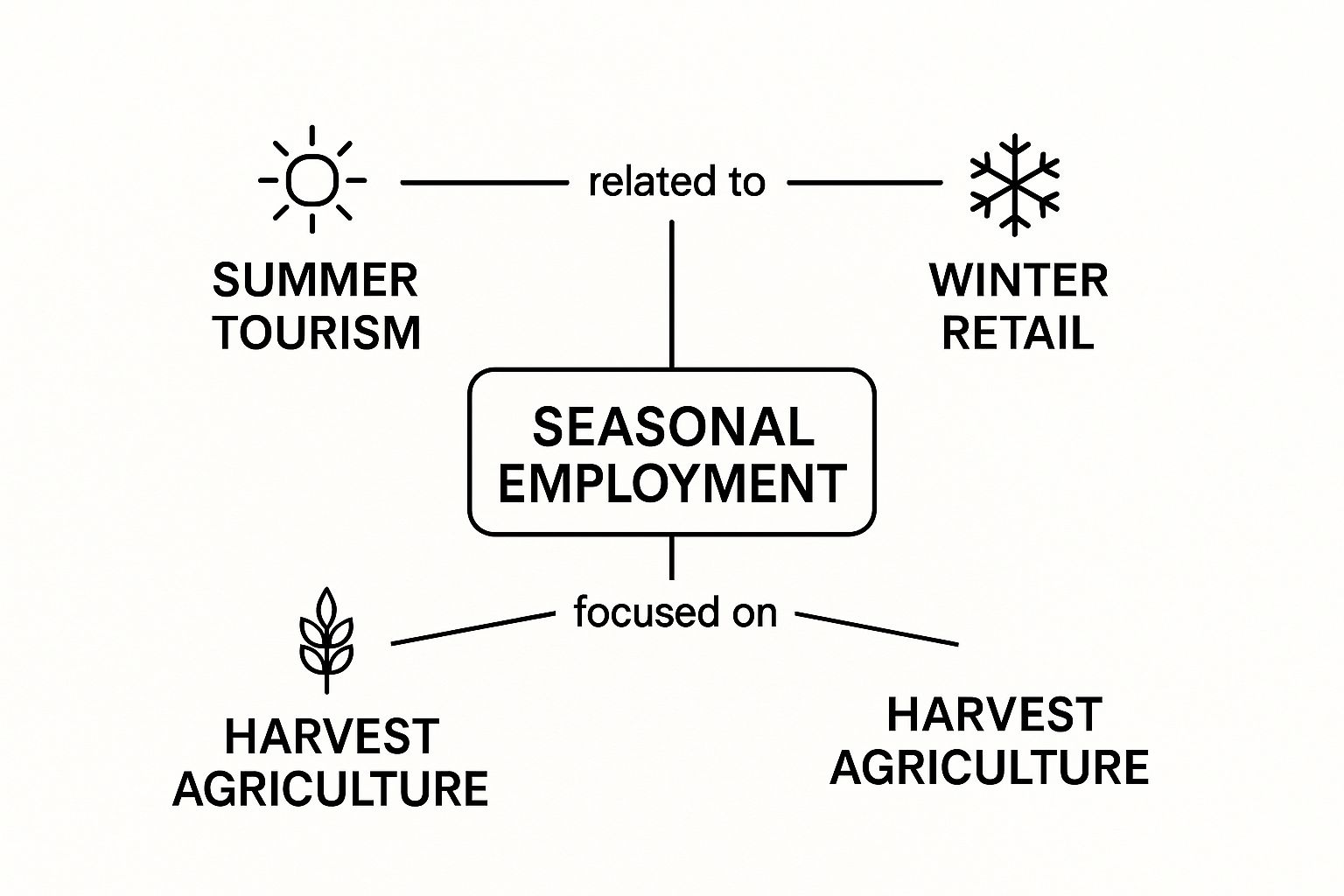Contents
- Your Complete Guide to Mastering Seasonal Employment
- Understanding the Hidden Rhythms of Seasonal Employment
- Understanding India’s Labor Market
- The Proactive Approach
- The Ripple Effects That Nobody Talks About
- Real-World Impacts of Seasonal Shifts
- Seasonal Employment in India: A Closer Look
- Building Sustainable Seasonal Employment Strategies
- Industries That Have Cracked The Seasonal Code
- Retail Giants and the Holiday Rush
- Hospitality’s Seasonal Transformations
- Agriculture’s Rhythms of Labor
- Building Your Strategic Workforce Framework
- Forecasting Seasonal Staffing Requirements
- Building a Flexible Organizational Structure
- Creating and Maintaining a Talent Pipeline
- Navigating The Legal Landscape Without Getting Lost
- Employment Contracts and Wage Compliance
- Safety Protocols and Termination Procedures
- Documentation and Worker Classification
- Regulatory Reporting and Best Practices
- Recruitment Strategies That Actually Work
- Building Robust Candidate Pools During the Off-Season
- Leveraging Technology to Streamline Hiring
- Creating Compelling Seasonal Opportunities
- How RPO Solutions Transform Your Seasonal Game
- The Power of Specialized RPO Providers
- Evaluating and Structuring RPO Partnerships
- The Advantages of RPO for Seasonal Hiring
- When Does RPO Make Sense?
Seasonal Employment
Your Complete Guide to Mastering Seasonal Employment
Understanding the Hidden Rhythms of Seasonal Employment
Think of your business as a living, breathing entity, expanding and contracting with the seasons. Seasonal employment isn’t just about adding extra hands during busy periods; it’s about strategically using these natural ebbs and flows to your advantage. Successful businesses don’t just scramble for seasonal workers; they orchestrate their workforce like a well-conducted symphony.
They anticipate their needs months in advance, creating systems that scale smoothly and efficiently. This proactive approach stands in stark contrast to businesses that merely react to market demands. These reactive companies often find themselves in a last-minute frenzy, compromising on the quality of their hires or even losing business due to staffing shortages.
The key difference lies in a fundamental shift in perspective: seeing seasonal employment not as a recurring headache, but as a strategic opportunity. Imagine a mango orchard owner in Maharashtra. A reactive approach would involve frantically searching for workers once the mangoes are ripe. A strategic approach, on the other hand, would mean nurturing relationships with local communities and training potential workers well before the harvest season begins.
Understanding India’s Labor Market
Understanding the unique dynamics of India’s labor market is crucial for effective seasonal workforce planning. The Periodic Labour Force Survey (PLFS) offers valuable insights into these dynamics, including trends in seasonal employment. As of April 2025, the PLFS reported India’s overall unemployment rate at 5.1%, with a slightly higher rate of 5.2% for males. Discover more insights on the PLFS.
This data helps illustrate how seasonal changes influence employment rates across different demographics and regions, providing policymakers with real-time information to address seasonal employment challenges. Businesses can use this data to anticipate fluctuations and proactively adjust their workforce strategies.
The Proactive Approach
This proactive mindset requires a deeper understanding of the cyclical nature of your specific industry. It means analyzing historical data, forecasting future trends, and building a flexible organizational structure. This involves creating a talent pipeline that can be activated on demand, ensuring seamless scaling without sacrificing service quality or company culture.
Just as a conductor prepares an orchestra for a complex performance, strategic seasonal employers prepare their workforce for the demands of peak seasons, turning potential chaos into a harmonious and productive flow.
The Ripple Effects That Nobody Talks About

When the holiday decorations come down and the shopping frenzy fades, the impact of seasonal employment reaches far beyond individual businesses. Think of it like ripples spreading across a pond – the effects of these workforce shifts reshape communities and local economies.
Imagine the quiet that settles over a bustling beach town once the tourists leave, or the slowdown in rural farmlands after the harvest. These aren’t just numbers on a spreadsheet; they’re real changes in people’s lives and livelihoods.
Real-World Impacts of Seasonal Shifts
Let’s take Goa, for instance. Once the tourist season ends, local businesses and families dependent on that influx of visitors see a significant dip in income. Similarly, in agricultural regions like Punjab, the period after harvest can lead to a scarcity of work for farm laborers.
These fluctuations don’t impact everyone equally. Younger workers and women often hold a larger share of seasonal jobs, making them more vulnerable during the off-season. This can create a cycle of economic instability, especially in rural communities with fewer alternative job options.
Seasonal Employment in India: A Closer Look
Seasonal changes, like the post-harvest period, significantly affect employment patterns in India. In May 2025, for example, India’s unemployment rate climbed to 5.6% from 5.1% the previous month, largely due to seasonal variations and reduced rural work. This impact was especially felt by young people and women, with unemployment among those aged 15-29 jumping to 15% in May, up from 13.8% in April. This highlights the struggles seasonal workers face during downtimes, particularly in rural areas where job opportunities become scarce. Discover more insights here.
Building Sustainable Seasonal Employment Strategies
Understanding these human impacts isn’t just about corporate social responsibility—it’s about smart business. Companies recognizing their role in these wider economic patterns are adapting their strategies. They’re moving beyond simply filling temporary positions and focusing on approaches that benefit both their bottom line and the communities they operate in.
This involves investing in training and development programs for seasonal workers, offering more stable employment options, and collaborating with local communities to build more resilient local economies. It’s a shift that requires a deeper understanding of the connection between business operations and community well-being.
It’s about seeing your company not as a separate entity, but as a vital thread in the larger social and economic fabric. This interconnectedness is what truly defines sustainable and responsible seasonal employment.
Industries That Have Cracked The Seasonal Code
The idea of seasonal employment isn’t exactly groundbreaking. Some industries have practically built their entire business models around it. Imagine the rush of new hires at retail stores during Diwali, or the wave of workers heading to hill stations as the summer tourist season kicks off. This is the ebb and flow of seasonal employment, and this section explores how different sectors have become masters of managing these fluctuating staffing needs.
The infographic below offers a visual representation of how seasonal employment peaks across various industries.

As you can see, summer brings a surge in tourism-related jobs, while winter sees an uptick in retail hiring for the holidays. Agriculture, of course, experiences its peak employment during harvest time. These distinct patterns highlight the cyclical nature of seasonal employment and how it varies from sector to sector.
Retail Giants and the Holiday Rush
Retail is probably the most obvious example of successful seasonal employment management. Big names like Amazon have practically perfected the art of ramping up their workforce for the holiday rush. In 2024, for example, Amazon brought on a whopping 250,000 seasonal workers across the U.S., offering competitive wages and benefits. This strategic move not only ensures they can handle the holiday shopping frenzy but also provides valuable employment opportunities for seasonal workers.
Hospitality’s Seasonal Transformations
The hospitality sector, especially in tourist hotspots, also demonstrates effective seasonal strategies. Think about quiet resort towns that suddenly burst into life during peak season. Hotels, restaurants, and tour operators all drastically expand their teams to accommodate the influx of visitors. This kind of rapid scaling requires careful planning and streamlined recruitment processes to quickly attract and onboard new staff.
Agriculture’s Rhythms of Labor
Agriculture is another sector deeply connected to seasonal employment. The industry relies on a large influx of workers during planting and harvesting seasons. This often means managing complex logistics, like providing housing and transportation for workers coming from different regions. These particular challenges have led to the development of specialized labor management practices within the agricultural sector.
Let’s take a closer look at how these industries handle their unique seasonal employment challenges:
| Industry | Peak Season | Workforce Increase | Key Challenges | Success Strategies |
|---|---|---|---|---|
| Retail | Holiday Season (November-December) | Significant increase (e.g., Amazon’s 250,000 hires in 2024) | Managing high volume hiring, training, and retention during short periods. | Streamlined application processes, competitive wages and benefits, clear communication. |
| Hospitality | Tourist Season (varies by location) | Varies depending on location and demand | Quickly onboarding and training staff, managing housing in popular destinations. | Partnerships with recruitment agencies, flexible work arrangements, employee referral programs. |
| Agriculture | Planting and Harvesting Seasons (varies by crop) | Significant increase, often reliant on migrant workers | Logistics of housing and transportation, ensuring fair labor practices. | Specialized labor management practices, collaboration with local communities, technology for tracking and managing workers. |
The table above illustrates the different peak seasons, workforce increases, key challenges, and success strategies employed across these industries. It’s clear that each sector has developed its own methods for effectively managing seasonal workforces.
Each of these industries has learned to optimize its workforce to align with the natural rhythm of its business. This involves understanding the precise timing and duration of peak seasons, accurately forecasting demand, and implementing systems to scale teams up and down efficiently.
Building Your Strategic Workforce Framework

Smart companies don’t just fill seasonal positions randomly; they build strategic frameworks. Think of it like constructing a building. You wouldn’t start without a blueprint, right? The same goes for seasonal employment. A solid strategy needs a well-defined framework. Let’s explore how successful companies anticipate staffing needs and create solutions.
Forecasting Seasonal Staffing Requirements
Forget crystal balls. Forecasting is about using data to make smart decisions. Analyze past trends to understand seasonal patterns. For example, how many employees were needed during last year’s Diwali rush? What were the busiest sales days?
This historical data forms the basis for future predictions. But don’t stop there. Consider external factors, too. Is a new competitor entering the market? Are there upcoming festivals or events that could boost demand? Looking at both past data and current conditions creates more accurate forecasts for your seasonal employment needs.
Building a Flexible Organizational Structure
Like a tree bending in the wind, your organization needs to adapt to seasonal changes. This isn’t about constant restructuring. It’s about building adaptable systems and processes.
Clearly defined roles for seasonal workers are key. This allows for quick integration and efficient contributions. Cross-training existing employees to handle multiple roles during peak seasons is another smart move. This creates a more versatile and adaptable team.
Creating and Maintaining a Talent Pipeline
Imagine your talent pipeline as a garden. You nurture it consistently, even when you’re not harvesting. This means identifying potential candidates before you need them. Attend job fairs, connect with local colleges, or build a database of qualified applicants.
For instance, a Goa hospitality business could partner with regional hospitality schools to identify promising students for future seasonal employment. These ongoing relationships ensure a readily available talent pool when the busy season hits. This proactive approach reduces last-minute hiring stress and guarantees access to a skilled workforce.
Attracting seasonal workers also requires understanding their motivations. Competitive wages and benefits are essential, but flexible schedules and skill development opportunities are equally valuable.
Navigating The Legal Landscape Without Getting Lost
The compliance requirements surrounding seasonal employment can feel overwhelming, but successful companies have mastered the art of navigating these complexities. This section breaks down the essential legal aspects every business should consider when developing its seasonal workforce strategy.
Employment Contracts and Wage Compliance
Think of an employment contract as a mutually beneficial agreement, a handshake between employer and employee. It clarifies the terms of the working relationship, protecting both sides. For seasonal workers, it’s crucial to clearly define the employment duration, compensation, and specific responsibilities. This transparency prevents misunderstandings and potential conflicts later on.
Wage compliance is another cornerstone of responsible employment practices. Ensure your business adheres to minimum wage laws and overtime regulations. Seasonal workers, despite their temporary status, are entitled to fair compensation. Overlooking these details can result in legal issues and harm your company’s reputation.
Safety Protocols and Termination Procedures
Seasonal workers deserve the same safe working environment as permanent employees. This includes comprehensive training on safety procedures and access to necessary safety equipment. Imagine a seasonal worker on a construction site without proper safety training—the risks are obvious.
Termination procedures require careful thought. Seasonal employment naturally has a defined end date, but unplanned terminations must be handled fairly and within legal boundaries. Clear guidelines and open communication channels can prevent disputes and ensure a smooth transition for everyone involved.
Documentation and Worker Classification
Meticulous record-keeping is crucial for compliance. Proper documentation of employment agreements, hours worked, and any incidents is essential. This creates a clear audit trail, safeguarding your business in case of legal inquiries.
Correct worker classification is equally important. Are your seasonal workers genuinely independent contractors, or are they employees? This distinction has significant implications for taxes, benefits, and legal responsibilities. Misclassification can result in hefty penalties.
Regulatory Reporting and Best Practices
Successfully managing the legal aspects of seasonal employment often involves industry-specific and region-specific regulatory reporting. Stay informed about these requirements to avoid potential fines and legal complications.
Learn from organizations with established seasonal employment programs. Explore more insights on the India Skills Reports. Many businesses share best practices and resources to help others maintain compliance. This collective knowledge can be invaluable in building a robust and legally sound approach to seasonal employment.
By addressing these legal considerations, you’re not just fulfilling obligations—you’re fostering trust and fairness within your seasonal workforce. This approach not only minimizes legal risks but also builds a positive brand image and attracts top-tier seasonal talent.
Recruitment Strategies That Actually Work

Recruiting for seasonal employment is a different ballgame than your typical hiring process. You need people fast, sure, but you can’t afford to sacrifice quality. Imagine trying to staff up a busy market stall during Diwali – you need to find skilled vendors quickly, but they also need to be dependable and offer good products.
This section dives into how successful companies manage to attract, evaluate, and onboard seasonal workers efficiently without compromising their standards. For a broader look at smart recruitment practices, check out this helpful guide: How to Hire Top Talent: Accelerate Recruitment in 2023.
Building Robust Candidate Pools During the Off-Season
Smart businesses know that preparing for seasonal employment is a year-round endeavor. They don’t wait for the hiring frenzy to hit; they proactively build talent pools during the off-season. It’s like a farmer preparing the soil long before planting – that preparation is key to a successful harvest later on.
One proven strategy is connecting with local colleges and vocational schools. These institutions are goldmines of young talent eager for seasonal opportunities. Picture a hotel chain partnering with a hospitality school to identify promising candidates for the upcoming summer tourist season.
Keeping a database of past seasonal employees is another smart move. These returning workers are already familiar with the job, which saves time and money on training. Sweetening the deal with incentives for re-engagement makes this pool of ready-to-go talent even more appealing.
Leveraging Technology to Streamline Hiring
Technology is indispensable for modern seasonal recruitment. Applicant Tracking Systems (ATS), for example, automate tedious tasks like screening resumes and scheduling interviews, freeing up recruiters to connect with the best candidates.
Online job boards and social media platforms widen your net, letting you target specific skills and demographics. Virtual job fairs and online assessments also help expedite the evaluation process, which is especially critical when you’re hiring a large number of seasonal workers.
Creating Compelling Seasonal Opportunities
Just like a vibrant market stall draws in customers, attracting seasonal workers means offering something worthwhile. Competitive wages are a given, but think about additional perks like flexible schedules, skill development programs, or employee referral bonuses.
Seasonal roles can also be a stepping stone to permanent positions. Amazon, for example, sees a significant number of seasonal employees transition to full-time roles. This potential for career growth makes seasonal opportunities much more attractive.
Finally, a smooth onboarding experience is essential. Efficient onboarding gets new hires up to speed quickly and reinforces a positive company culture. This creates a welcoming environment and encourages seasonal workers to return in the future.
To help you visualize the timing of seasonal recruitment, we’ve put together a handy timeline:
Introducing the “Seasonal Recruitment Timeline and Milestones” table, a strategic guide to help you time your recruitment activities for maximum impact.
| Activity | Timing Before Peak | Duration | Key Deliverables | Success Metrics |
|---|---|---|---|---|
| Building Talent Pools | 6-12 months | Ongoing | Database of potential candidates, relationships with schools | Number of potential candidates, engagement with schools |
| Marketing & Outreach | 3-6 months | 2-3 months | Job postings, social media campaigns | Applicant traffic, brand visibility |
| Screening & Interviews | 2-4 months | 4-6 weeks | Shortlisted candidates | Number of qualified applicants, time-to-fill |
| Onboarding | 1-2 weeks | 1-2 weeks | Trained and ready employees | Employee satisfaction, time-to-productivity |
This table provides a framework for planning your seasonal recruitment efforts, highlighting key activities and their ideal timing. By starting early and focusing on building relationships and engaging with potential candidates, you can ensure a successful seasonal hiring season.
How RPO Solutions Transform Your Seasonal Game
Managing seasonal employment can feel like a high-wire act. The timing is crucial, the demands fluctuate, and the pressure is always on. Imagine having a trusted partner to help you navigate these challenges. That’s where Recruitment Process Outsourcing (RPO) steps in. Think of it as bringing in a seasoned expert to help you manage the complexities of your seasonal workforce.
RPO isn’t just about filling positions; it’s about building a strategy that ensures you have the right people at the right time, without the headaches.
The Power of Specialized RPO Providers
Think of specialized RPO providers as expert consultants for your seasonal staffing needs. They’re not generic recruiters; they understand the unique rhythm of your industry and the specific skills required for peak seasons. They know the local talent pool and have established networks to tap into.
Imagine a chocolate company gearing up for the holiday rush. Instead of scrambling to find temporary workers, they partner with an RPO provider specializing in food manufacturing. This provider already has connections with experienced seasonal workers, understands food safety regulations, and can quickly onboard new hires, ensuring the company is ready for increased production demands.
Evaluating and Structuring RPO Partnerships
Choosing the right RPO partner is a crucial decision. It’s like selecting the right conductor for an orchestra – you need someone who understands the music and can lead the team effectively. Look for providers with a proven track record in your sector and a deep understanding of your region’s labor market.
Structuring the RPO agreement is equally important. It’s about creating a partnership that fits your specific needs. The agreement should be tailored to your seasonal demands, whether it’s a short burst of hiring for a festival season or ongoing support throughout the year. Clear performance indicators, like time-to-fill and cost-per-hire, should be defined from the start to ensure alignment and shared success.
The Advantages of RPO for Seasonal Hiring
Partnering with an RPO provider offers several key benefits:
- Ready-to-Go Candidate Networks: They’ve already done the groundwork of building relationships with qualified candidates, saving you valuable time and effort.
- Industry-Specific Knowledge: They understand the intricacies of your industry and the particular challenges of seasonal hiring.
- Fast and Efficient Scaling: They’re equipped to handle large-volume hiring quickly and efficiently.
- Compliance Confidence: They navigate the often-complicated legal aspects of seasonal employment, reducing your risk.
These advantages can be especially helpful for businesses dealing with significant seasonal fluctuations in their workforce. You might also be interested in: Taggd’s RPO services.
When Does RPO Make Sense?
RPO isn’t a universal solution. It’s most beneficial for companies experiencing significant seasonal variations in staffing needs or those finding it difficult to manage seasonal hiring internally.
Factors like your company size, industry, and specific seasonal requirements play a role in determining whether RPO is the right choice. A small local business may have different needs than a large national company.
Ultimately, RPO is about bringing in expert support to optimize your seasonal employment strategy. It allows you to focus on your core business while ensuring you have the right team in place at the right time.
Ready to take your seasonal employment strategy to the next level? Explore how Taggd can help you build a winning seasonal workforce.
